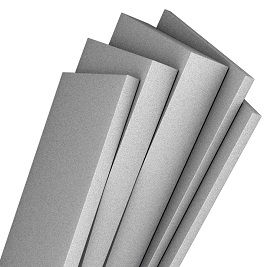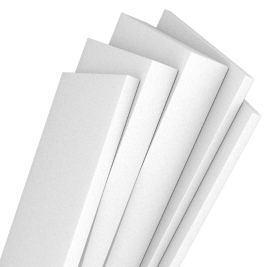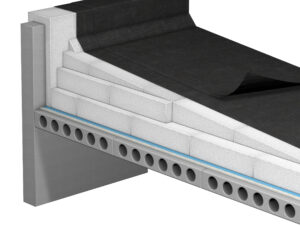Tapered roof
Creating slopes
The planes for slopes are specially cut polystyrene foam sheets which are most commonly used to create relief in gently sloping roof structures. Most often planes are placed in two or several layers where the bottom layer ensure technical heating parameters, but the last sheet gives the slope. However, the material can be used for creating slopes on other levelled surfaces, e.g. balconies, bathrooms, and for levelling uneven surfaces. You can create a slope starting from 1%. The standard size of plates is 1000x1000mm.
Technical thermal properties
The heat penetration of the insulation material can be from 0.031 to 0.038 W/m*K, which is a highly notable level. Furthermore, the material can be light and at the came time can withstand large loads. The sloping layer serves two functions – gives the necessary relief and serves as an additional heater. Bearing in mind the product’s properties, it can be applied and adjusted for almost all projects. E.g. a gently sloping roof made of “grey” polystyrene foam with a green area was awarded with the Annual Design Award for excellent technical solution. In comparison with analogue solutions, NEO EPS allowed reducing load on roof constructions almost 4 times.
Load resistance
The long-term load resistance (50 years) of polystyrene foam EPS 100 most commonly used in this solution is 27.3 kPa which is 2,700 kg/m2. Such material durability is sufficient to withstand snow, rain and wind-crated loads and stress on the roof create by movement of servicing staff. There other polystyrene foam types available. The most durable is EPS 200 which can withstand a load of 54.5 kPa which is enough for such applications as green roof and others. At the same time, the densest material weighs only 31 kg/m3; therefore, it does not create an additional load on the building’s structures.
Applicability
To create energy-efficient roof thermal insulation solution, it is necessary to understand the applicability of an insulation material through assessing the following material properties:
- created heat resistance,
- thickness of insulation layer,
- long-term load-resistance,
- small weight of material,
- simplicity of mounting,
- availability and applicability of sloping components,
- ecologic nature of materials.
EPS insulation meets all these criteria. Furthermore, bearing in mind the small density of the material, it guarantees high-quality long-term load resistance. Such properties lead to highly energy-efficient and simple green roof solutions, giving buildings highly valuable aesthetic outlook.
Simplicity of mounting
Before ordering thermal insulation planes, it is necessary to send the factory the building’s roof design with drainage placement and desired slope. According to this information, the factory will draw the plane placement plan with accurate material specification. The planes will be delivered to the site with a placement plan where each plane will be marked. Starting the mounting works from drainage hoppers, it is easy to follow the mounting sequence and use the required planes. The material shows small density and therefore can be easily moved and placed by workers. Furthermore, polystyrene foam planes can be cut on-site by using a regular hand saw.
Placement of waterproofing
For hydro insulation of gently sloping planes, one should opt to choose a material with three different attaching approaches – melting, gluing or mechanically fixing hydro insulation. Depending on the selected material, the fixing technology can be slightly different. Before commencing any mounting works, it is necessary to consult the manufacturer or distributor of the product to find out information on its fixing approaches. depending on the selected mounting type, the thermal insulation mounting can also be different. Gluing or mechanically fixing hydro insulation can be fixed directly on polystyrene foam without any intermediary layers. If you opt to use melting insulation above sloping planes, it is necessary to mount additional separating layer (at least 20 mm thick) with non-combustible thermal insulation – stone wool or analogue material. Such a solution is necessary because the maximum operational temperature of polystyrene foam is +80 C; any excessive temperatures might harm the material.
| Solution products | Fire reaction class | Sizes | Thermal conductivity coefficient | Compression tensions | Tensile strength | Long-term water absorption | # |
|---|---|---|---|---|---|---|---|
 TENAPORS NEO EPS 150 | |||||||
| - |  TENAPORS NEO EPS 100 | ||||||
| - |  TENAPORS NEO EPS 80 | ||||||
 TENAPORS EPS 200 | |||||||
| - | - |  TENAPORS EPS 120 | |||||
| - |  TENAPORS EPS 100 | ||||||
| - |  TENAPORS EPS 80 | ||||||
| - |  TENAPORS EPS 150 |


